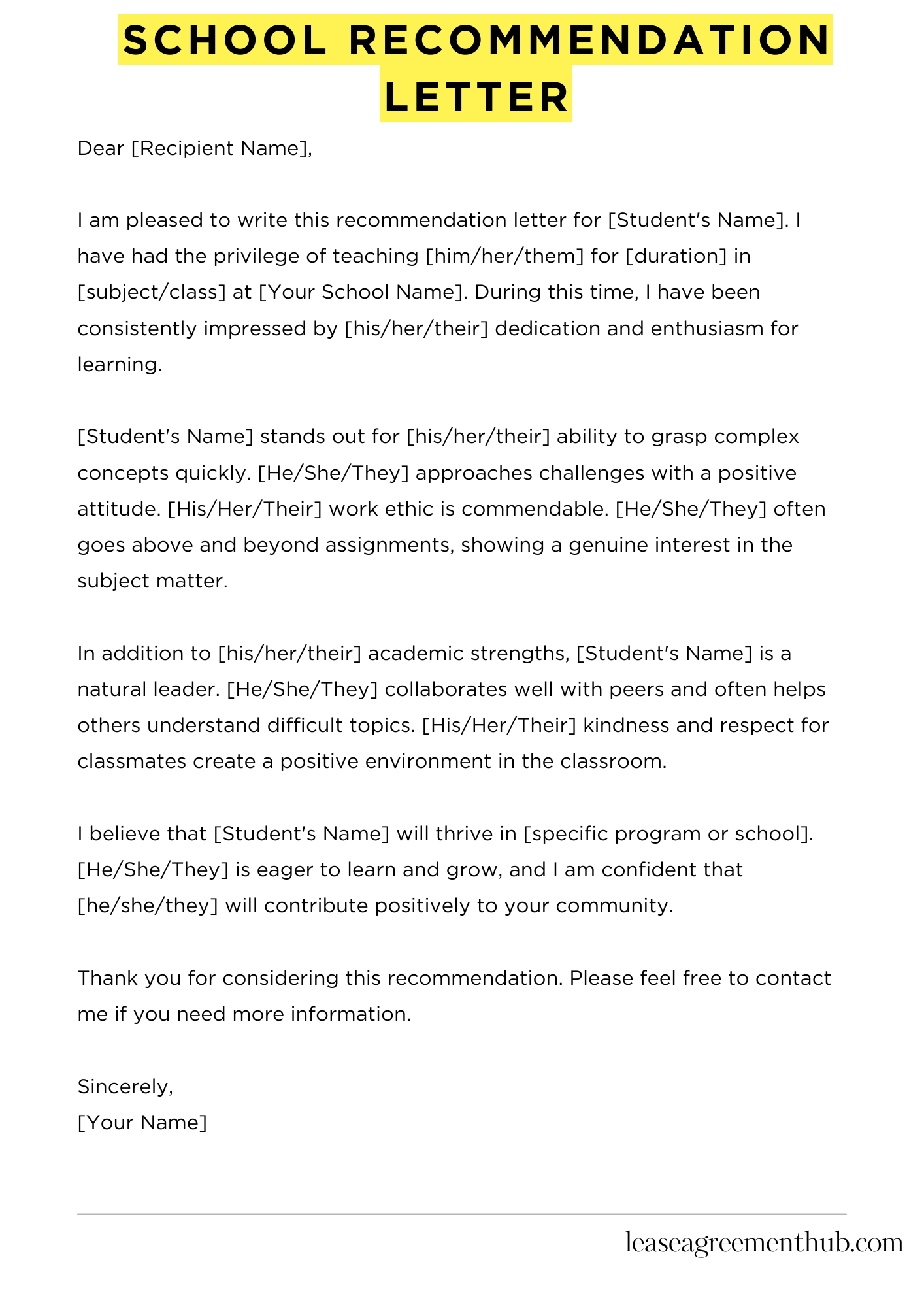A school recommendation letter is a written endorsement of a student by a teacher, counselor, or other school official. Its main purpose is to provide insights into a student’s abilities, character, and achievements. These letters play a crucial role in college applications and scholarship opportunities, helping students stand out in a competitive environment.
In this article, we will share various templates and examples of school recommendation letters. These samples are designed to guide you in crafting your own letter. Whether you are a teacher writing for a student or a student requesting a letter, these resources will simplify the process.
Writing a recommendation letter can be challenging, but it doesn’t have to be. With our easy-to-follow examples, you will find it easier to express your thoughts clearly and effectively. You will be able to create a compelling letter that highlights the best qualities of the student.
School Recommendation Letter
[Your Name]
[Your Position]
[Your School/Organization Name]
[Your Address]
[City, State, Zip Code]
[Email Address]
[Phone Number]
[Date]
[Recipient Name]
[Recipient Position]
[Recipient School/Organization Name]
[Recipient Address]
[City, State, Zip Code]
Dear [Recipient Name],
I am pleased to write this recommendation letter for [Student’s Name]. I have had the privilege of teaching [him/her/them] for [duration] in [subject/class] at [Your School Name]. During this time, I have been consistently impressed by [his/her/their] dedication and enthusiasm for learning.
[Student’s Name] stands out for [his/her/their] ability to grasp complex concepts quickly. [He/She/They] approaches challenges with a positive attitude. [His/Her/Their] work ethic is commendable. [He/She/They] often goes above and beyond assignments, showing a genuine interest in the subject matter.
In addition to [his/her/their] academic strengths, [Student’s Name] is a natural leader. [He/She/They] collaborates well with peers and often helps others understand difficult topics. [His/Her/Their] kindness and respect for classmates create a positive environment in the classroom.
I believe that [Student’s Name] will thrive in [specific program or school]. [He/She/They] is eager to learn and grow, and I am confident that [he/she/they] will contribute positively to your community.
Thank you for considering this recommendation. Please feel free to contact me if you need more information.
Sincerely,
[Your Name]

How to Write School Recommendation Letter
Understanding the Purpose
A school recommendation letter serves as a personal endorsement for a student. It highlights their strengths, achievements, and character. This letter is often required for college applications, scholarships, or special programs. It gives the admissions committee insight into the student beyond grades and test scores.
Gathering Information
Before you start writing, collect relevant information. Talk to the student about their goals, interests, and achievements. Ask for a resume or a list of their extracurricular activities. This will help you create a more personalized letter. Knowing the specific program or school they are applying to can also guide your writing.
Structuring the Letter
Begin with a formal greeting. Address the letter to the appropriate person, if known. Start with an introduction that states your relationship with the student. Mention how long you have known them and in what capacity. The body of the letter should include specific examples of the student’s skills and accomplishments. Highlight qualities such as leadership, teamwork, and dedication. Conclude with a strong recommendation, encouraging the reader to consider the student seriously.
Using a Positive Tone
While writing, maintain a positive and supportive tone. Use enthusiastic language that reflects your genuine belief in the student’s potential. Avoid vague statements; instead, focus on concrete examples that illustrate the student’s abilities. This approach makes your recommendation more compelling and credible.
Proofreading and Finalizing
After completing the letter, take time to proofread it. Check for spelling and grammatical errors. Ensure that the letter flows well and maintains a professional tone throughout. If possible, ask someone else to review it. A fresh set of eyes can catch mistakes you might have missed. Once satisfied, print the letter on official letterhead and sign it, if required.
Related: